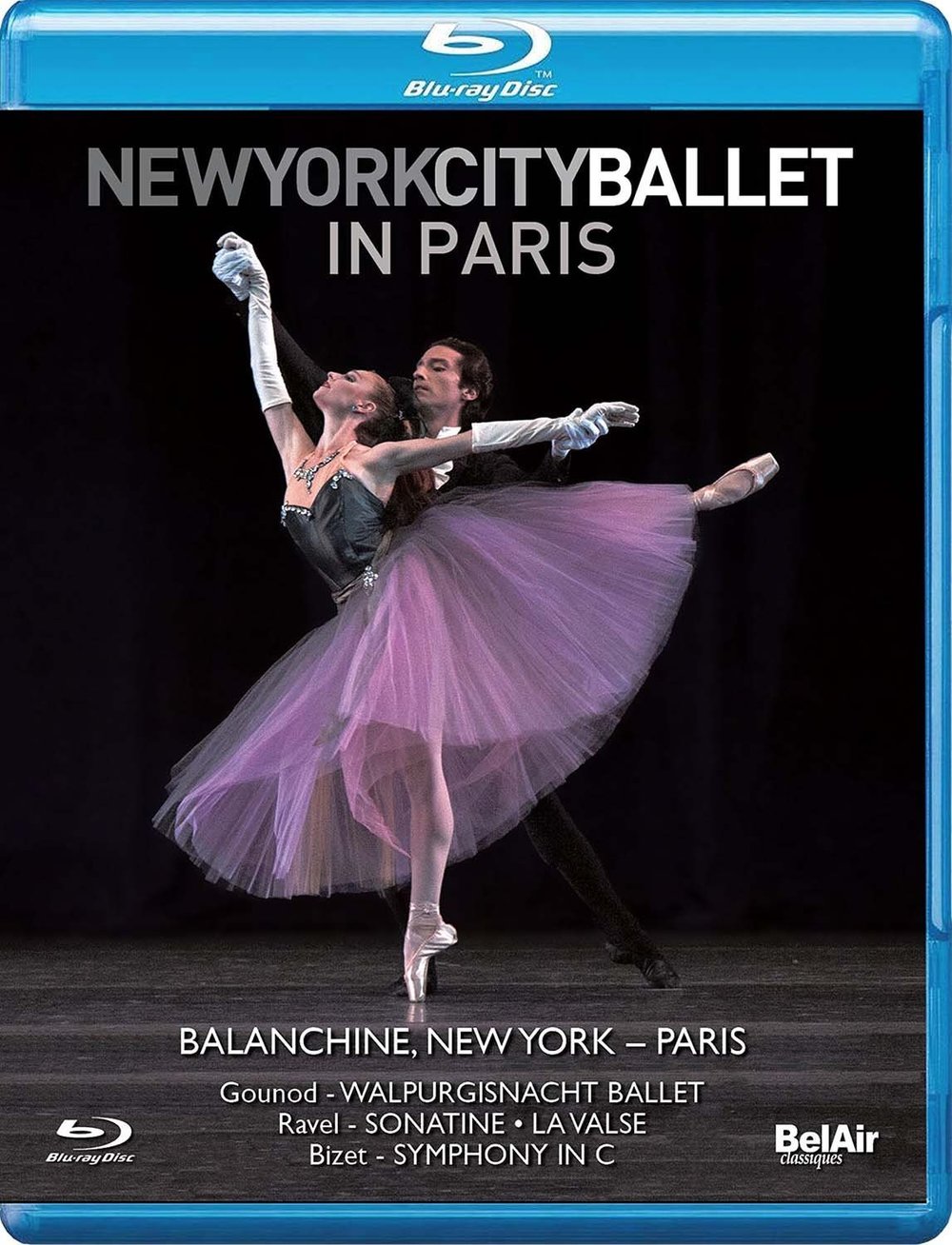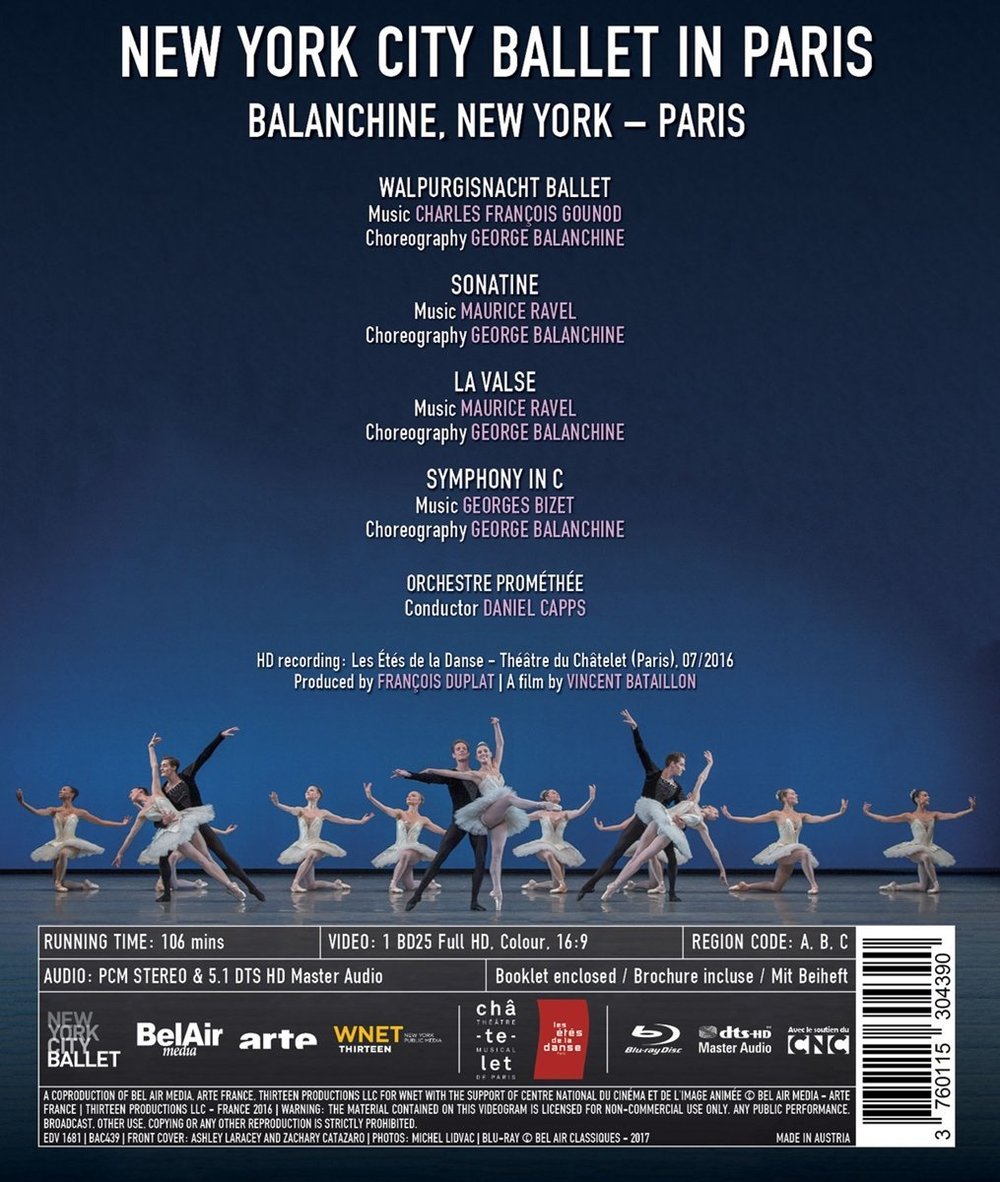

New York City Ballet in Paris show of 4 one-act works, choreographed by George Balanchine, each to pieces of French music. Performed in 2016 at the Paris Théâtre du Châtelet as part of Les Etés de la Danse (The Summers of Dance Festival). Here’s the program:
Walpurgisnacht Ballet from the Charles Gounod Faust opera, first performed as an independent piece by the NYCB in 1980. Stars Sara Mearns, Adrian Danchig-Waring, Louren Lovette, Kristen Segin, and Sarah Villwock. Costumes by Karinska (Barbara Karinska: 1886-1983, Balanchine's favorite costume designer); lighting by Mark Stanley.
Sonatine by Ravel, a pas de deux originally written for Violette Verdy and Jean-Pierre Bonnefoux in 1975. Stars Megan Fairchild and Joaquin De Luz with solo pianist Elaine Chelton. Lighting by Mark Stanley.
La Valse, also created to famous music of Ravel in 1951. Stars Sterling Hyltin, Jared Angle, and Amar Ramasar with Marika Anderson, Meaghan Dutton-O'Hara, Gwyneth Muller, Lauren King, Antonio Carmena, Ashley Laracey, Zachary Catazaro, and Ralph Ippolito. Scenery by Jean Rosenthal; costumes by Karinska; lighting by Mark Stanley.
Symphony in C to the Georges Bizet Symphony No. 1 in C Major, created in 1947. (The original name of the ballet was Le Palais de Cristal). This ballet is performed by more than 50 dancers led by Tiler Peck, Andrew Veyette, Teresa Reichlen, Tyler Angle, Alston Macgill, Anthony Huxley, Brittany Pollack, and Taylor Stanley. Costumes by Marc Happel; lighting by Mark Stanley.
Daniel Capps conducts L'Orchestre Prométhée. Directed for TV by Vincent Bataillon; produced by François Duplat. Released 2017, disc has 5.1 dts-HD Master Audo Grade: A
This was shown as a Great Performances broadcast on PBS in 2017. Alastair Macaulay, the chief dance critic for the New York Times, saw this on PBS TV and gave his stamp of approval for the dancing. He also praised the filming by Vincent Bataillon for "sensitive camerawork, in which the screen alternates, excitingly and musically, between long shots showing the full company and full-length views of leading dancers." Right on Alastair! As we have demonstrated on this website, Bataillon is in a class by himself as the leading ballet videographer in the world. Alas, Alastair also expressed the hope that the TV show will become a DVD. Oh, forgive the print critics: they know not what they are missing! Turns out this was published in Blu-ray (and as a DVD).
Time for screenshots! First below is a pretty whole-stage shot from the opening of Walpurgisnacht Ballet. I did a Ballet Wonk Worksheet on this title. Across all 4 works on the disc, 50% of Bataillon's video clips show the entire stage:
And next below is a beautiful part-stage, whole-body shot from the same scene as above. 46% of Bataillon's clips are from this range. So 96% of the clips on this disc show the whole bodies of the dancers:
Sara Mearns:
I think the dancer in the center in the lighter dress is Lauren Lovette:
Megan Fairchild and Joaquin de Luz in the Sonatine duet:
It was hard to get screenshots from the dark La Valse. The next 4 views below are the best I could do. Ravel's music becomes increasingly disjointed and neurotic before it collapses into a death spiral:
Here below is one of only 7 torso shots in the entire disc. Since all 4 of the dances on this program are abstract with only minimal story-telling, Bataillon only rarely goes in for close for facial expressions. There is a single close-up in the whole disc: the appearance later in La Valse of Death. Balanchine presents Death in a completely naturalistic way, but there's no doubt about who he is. Bataillon zooms in for further emphasis, and this surprise is effective. Alas, the close-up of Death is too dark to work for a screenshot, but it looks fine on the TV display:
The party is over:
Balanchine is endlessly creative in his dance moves, and I saw a huge number of steps in this program that I'd never seen before. But the view next below has to be a quote from The Rite of Spring (I counted this as a torso shot):
Now we move to Symphony in C, which is probably Balanchine's most important ballet, though perhaps not as famous as his Jewels. Balanchine first learned ballet in the Russian Imperial system which had been dominated by Tchaikovsky (who died about 10 years before Balanchine was born) and Petipa (who died when Balanchine was 6). He was able to flee Russia in 1924 and eventually, after many adventures, arrived in the United States in 1933 where he founded the New York City Ballet. Both the resources available to Balanchine in New York and the audience he had to sell to were primitive compared to what he had known in Imperial Russia and the other capitals of Europe. But Balanchine was able to transplant the essence of classical Russian ballet to the United States! This essence was called the Balanchine neo-classical style, and Symphony in C might viewed as the manifesto of the Balanchine approach. In the next 3 shots below, I note a modest cast on a stage with no set or props. But the costumes are gorgeous and dancing is formal, conservative, clean, and abstract. The women dominate our attention; the (few) men provide support:
As more members of the corps are committed, I sense elements of grandeur and a richness of formations and poses:
And in the last shot below, I am reminded of what is considered by many the greatest scene from all of Petipa, the Raymonda grand adagio of the pas classique hongrois:
Not sure about the Raymonda grand adagio of the pas classique hongrois? Well here are two shots from that scene for your reference:
Finally, we are getting something in Blu-ray from the New York City Ballet! None of the 4 dances on this disc have been published in Blu-ray before, so this is must-have for ballet fans. I already pointed out Bataillon's devotion to full body shots in his video. Bataillon also gives us a magisterial pace of 22+ seconds per video clip, which is consistent with his other great ballet videos. The music provided by Daniel Capps and L'Orchestre Prométhée is fine as are both PQ and SQ. As to a grade, I have only one reservation. The NYCB has a big operation and they are in a sense the direct heir of the greatest choreographer of the 20th century. (Balanchine's works actually belong to a charitable trust which has been accused by some of having the mission of turning all of Balanchine's work into museum pieces).
The NYCB dancers seem to be individually competitive with the best around the world. But I wonder how ardently the corps is adhering to the Balanchine principle of performing each piece now as well as possible without regard to what has gone before and assuming there will be no future. The NYCB has a huge repertory. But are they getting the drilling necessary to perform their major pieces with total authority? I sense a lack of attention to detail in the corps formations that Balanchine himself would have demanded. So I'm giving this an A. I'm going to include this title on my list of best ballets in HDVD, but without any special designation.
Here's the official trailer:
OR



















